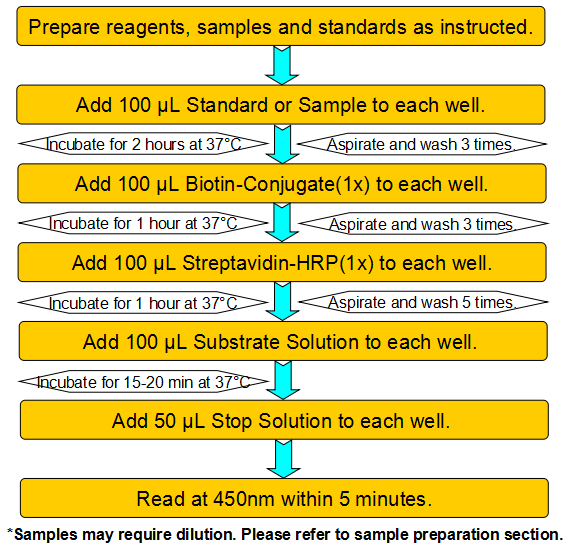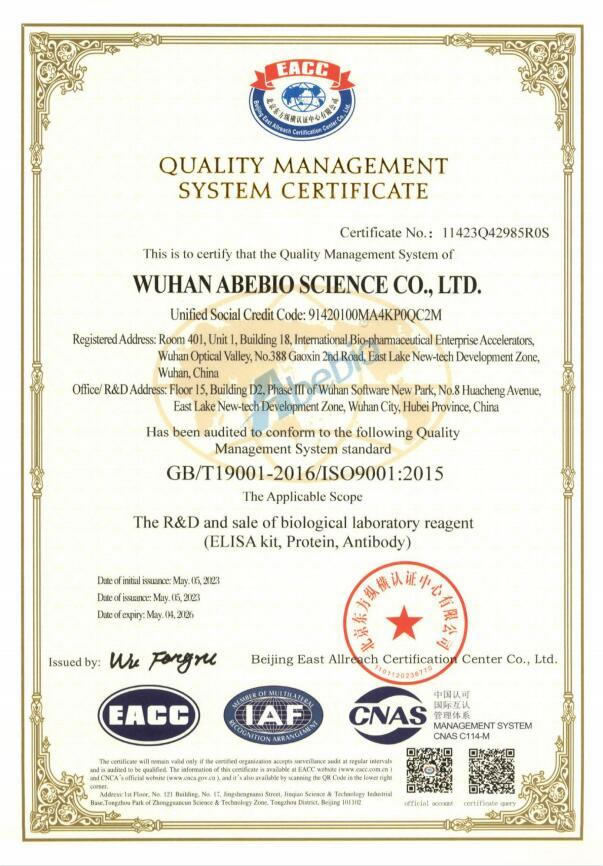Product Details
| Species Reactivity |
Human (Homo sapiens) |
| UniProt |
|
| Abbreviation |
ECHO-IgG |
| Alternative Names |
N/A |
| Range |
Request Information |
| Sensitivity |
Request Information |
| Sample Type |
Serum, Plasma, Other biological fluids |
| Detection Method |
Sandwich |
| Analysis Method |
Quantitive |
| Assay Duration |
1-4.5h |
| Sample Volume |
�1�-�2�0�0� μ�L |
| Detection Wavelengt |
450 nm |
Test principle
This assay employs a two-site sandwich ELISA to quantitate ECHO-IgG in samples. An antibody specific for ECHO-IgG has been pre-coated onto a microplate. Standards and samples are pipetted into the wells and any ECHO-IgG present is bound by the immobilized antibody. After removing any unbound substances, a biotin-conjugated antibody specific for ECHO-IgG is added to the wells. After washing, Streptavidin conjugated Horseradish Peroxidase (HRP) is added to the wells. Following a wash to remove any unbound avidin-enzyme reagent, a substrate solution is added to the wells and color develops in proportion to the amount of ECHO-IgG bound in the initial step. The color development is stopped and the intensity of the color is measured.
Product Overview
An ECHO (enteric cytopathic human orphan) virus is a type of RNA virus that belongs to the species Enterovirus B, genus Enterovirus of the Picornaviridae family. Echoviruses are found in the gastrointestinal tract (hence it being part of the enterovirus genus) and exposure to the virus causes other opportunistic infections and diseases.
Echovirus is highly infectious, and its primary target is children. The echovirus is among the leading causes of acute febrile illness in infants and young children, and is the most common cause of aseptic meningitis. Infection of an infant with this virus following birth may cause severe systemic diseases, and is associated with high infant mortality rates. The echovirus can mimic symptoms caused by other common bacterial and viral infections.
Components
Reagents |
Quantity |
Reagents |
Quantity |
Assay plate (96 Wells) |
1 |
Instruction manual |
1 |
Standard (lyophilized) |
2 |
Sample Diluent |
1 x 20 mL |
Biotin-Conjugate (concentrate 100 x) |
1 x 120 μL |
Biotin-Conjugate Diluent |
1 x 12 mL |
Streptavidin-HRP (concentrate 100 x) |
1 x 120 μL |
Streptavidin-HRP Diluent |
1 x 12 mL |
Wash Buffer (concentrate 25 x) |
1 x 20 mL |
Substrate Solution |
1 x 10 mL |
Stop Solution |
1 x 6 mL |
Adhesive Films |
4 |
Specificity
This assay has high sensitivity and excellent specificity for detection of Human ECHO-IgG. No significant cross-reactivity or interference between Human ECHO-IgG and analogues was observed.
Recovery
Matrices listed below were spiked with certain level of recombinant Human ECHO-IgG and the recovery rates were calculated by comparing the measured value to the expected amount of Human ECHO-IgG in samples.
Precision
Intra-assay Precision (Precision within an assay)
Three samples of known concentration were tested twenty times on one plate to assess intra-assay precision.
Inter-assay Precision (Precision between assays)
Three samples of known concentration were tested in forty separate assays to assess inter-assay precision.
CV (%) = SD/meanX100
Intra-Assay: CV<8%
Inter-Assay: CV<12%
Linearity
The linearity of the kit was assayed by testing samples spiked with appropriate concentration of Human ECHO-IgG and their serial dilutions. The results were demonstrated by the percentage of calculated concentration to the expected.
Stability
The stability of ELISA kit is determined by the loss rate of activity. The loss rate of this kit is less than 5% within the expiration date under appropriate storage condition.
The loss rate was determined by accelerated thermal degradation test. Keep the kit at 37°C for 4 and 7 days, and compare O.D.values of the kit kept at 37°C with that of at recommended temperature. (referring from China Biological Products Standard, which was calculated by the Arrhenius equation. For ELISA kit, 4 days storage at 37°C can be considered as 6 months at 2 - 8°C, which means 7 days at 37°C equaling 12 months at 2 - 8°C).
Sample collection and storage
�S�e�r�u�m�:� �U�s�e� �a� �s�e�r�u�m� �s�e�p�a�r�a�t�o�r� �t�u�b�e� �(�S�S�T�)� �a�n�d� �a�l�l�o�w� �s�a�m�p�l�e�s� �t�o� �c�l�o�t� �f�o�r� �t�w�o� �h�o�u�r�s� �a�t� �r�o�o�m� �t�e�m�p�e�r�a�t�u�r�e� �o�r� �o�v�e�r�n�i�g�h�t� �a�t� �2� �-� �8°�C� �b�e�f�o�r�e� �c�e�n�t�r�i�f�u�g�a�t�i�o�n� �f�o�r� �1�5� �m�i�n�u�t�e�s� �a�t� �1�0�0�0� ×� �g�.� �R�e�m�o�v�e� �s�e�r�u�m� �a�n�d� �a�s�s�a�y� �i�m�m�e�d�i�a�t�e�l�y� �o�r� �a�l�i�q�u�o�t� �a�n�d� �s�t�o�r�e� �s�a�m�p�l�e�s� �a�t� ≤� �-�2�0°�C�.� �A�v�o�i�d� �r�e�p�e�a�t�e�d� �f�r�e�e�z�e�-�t�h�a�w� �c�y�c�l�e�s�.�
�P�l�a�s�m�a�:� �C�o�l�l�e�c�t� �p�l�a�s�m�a� �u�s�i�n�g� �E�D�T�A�,� �o�r� �h�e�p�a�r�i�n� �a�s� �a�n� �a�n�t�i�c�o�a�g�u�l�a�n�t�.� �C�e�n�t�r�i�f�u�g�e� �f�o�r� �1�5� �m�i�n�u�t�e�s� �a�t� �1�0�0�0� ×� �g� �a�t� �2� �-� �8°�C� �w�i�t�h�i�n� �3�0� �m�i�n�u�t�e�s� �o�f� �c�o�l�l�e�c�t�i�o�n�.� �A�s�s�a�y� �i�m�m�e�d�i�a�t�e�l�y� �o�r� �a�l�i�q�u�o�t� �a�n�d� �s�t�o�r�e� �s�a�m�p�l�e�s� �a�t� ≤� �-�2�0°�C�.� �A�v�o�i�d� �r�e�p�e�a�t�e�d� �f�r�e�e�z�e�-�t�h�a�w� �c�y�c�l�e�s�.�
�O�t�h�e�r� �b�i�o�l�o�g�i�c�a�l� �f�l�u�i�d�s�:� �C�e�n�t�r�i�f�u�g�e� �s�a�m�p�l�e�s� �f�o�r� �2�0� �m�i�n�u�t�e�s� �a�t� �1�0�0�0� ×� �g�.� �R�e�m�o�v�e� �p�a�r�t�i�c�u�l�a�t�e�s� �a�n�d� �a�s�s�a�y� �i�m�m�e�d�i�a�t�e�l�y� �o�r� �s�t�o�r�e� �s�a�m�p�l�e�s� �i�n� �a�l�i�q�u�o�t� �a�t� �-�2�0°�C� �o�r� �-�8�0°�C�.� �A�v�o�i�d� �r�e�p�e�a�t�e�d� �f�r�e�e�z�e�/�t�h�a�w� �c�y�c�l�e�s�.
Kits storage instructions
Store at 2-8°C. Please refer to Instruction Manual.



